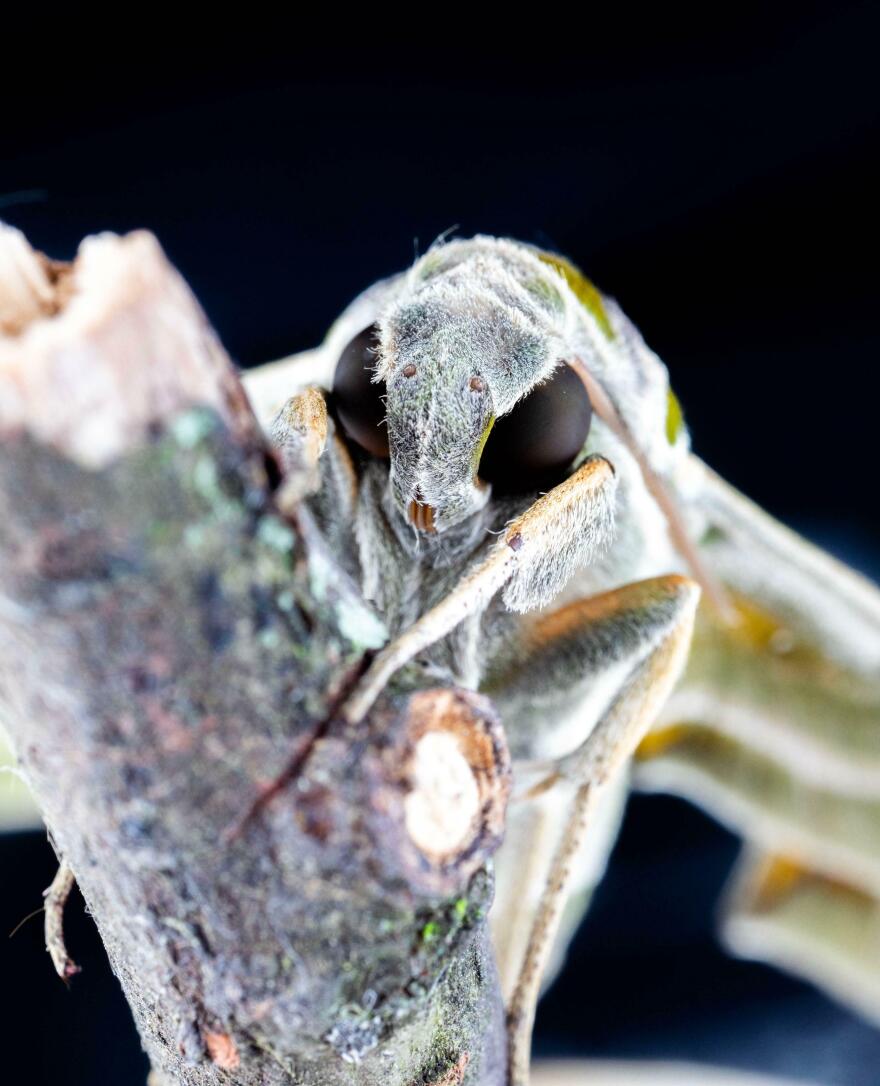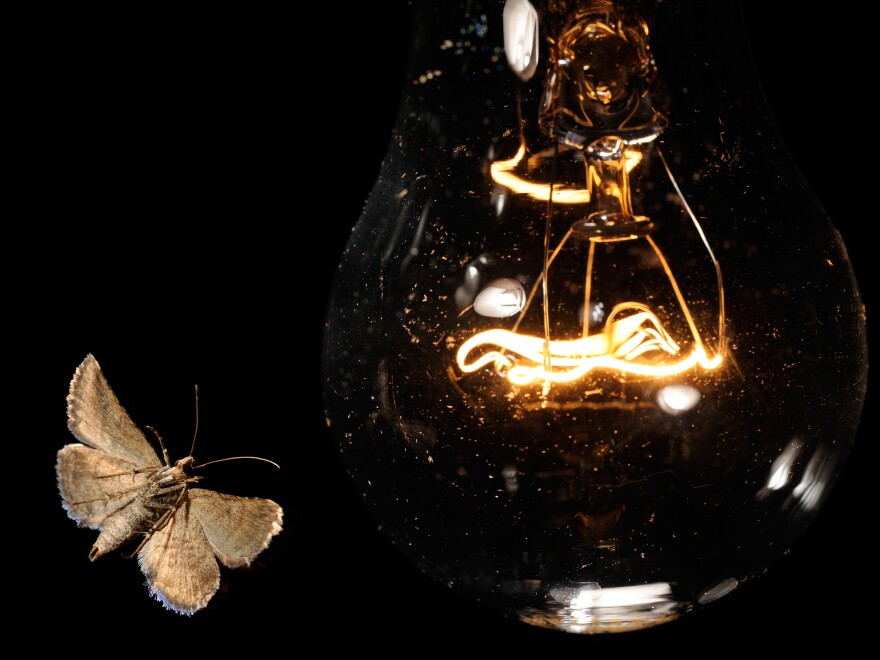Turn on a light outside at night, and it won't be long before a bevy of insects start careening wildly around it, apparently drawn in "like a moth to a flame," as the saying goes.
Now, in a series of studies that offer a new way of thinking about an old mystery, scientists say that insects do this because an artificial light can mess with their natural way of knowing what direction is "up" while flying.
Motion-capture videos of moths and other insects show that they seem to instinctively turn their backs to light, and try to fly so that their back is always facing the light source, according to a new report in the journal Nature Communications.
That habit makes sense in a dark, natural setting such as a forest because there, the star-strewn sky is typically the brightest source of light, the researchers say. Any insect that's been swooping around in all directions through the air can reorient itself by pointing its back towards this light.
"You can use that to work out which way is 'up' really, really fast, which is as important for insects as it is for airline pilots," says Sam Fabian, who studies insect flight at Imperial College London.
He notes that a flying insect, while veering this way and that, can quite often experience whole body accelerations that might be in the region of five times the acceleration due to gravity. That makes it hard to tell up from down, says Fabian, and for an insect, tilting its backside so that it faces the bright sky is a quick and easy method to get back on track.
"It's extremely smart because it's very finely tuned and it works beautifully until somebody invents the lamp or the light bulb," says Fabian, "and then it's suddenly not such a good idea anymore."
When the brightest light is coming from an artificial bulb, the new research shows, any insect that tries to keep its back tilted towards the brightness will start flying in crazed patterns of the kind that can be seen around any porch light.
"We've probably been wondering why moths fly to lights since the invention of fire," says Avalon Owens, an entomologist at Harvard University who studies the effect of artificial light on insects but was not part of this study.
"I, along with everybody else, was really excited by this," says Owens, adding that the new research has got entomologists talking. "The fact that after, like, literally millennia we have a new observation on this very old phenomenon is just absolutely buck wild to me."
Turning moths into movie stars
The inspiration for this study really came years ago, when Yash Sondhi visited a remote wildlife sanctuary in India with his parents as a high-schooler. There, Sondhi watched thousands of moths and other insects of various colors and shapes come to a bright light set up in the nighttime darkness.
"And I was like, 'Why are they even coming to light?'" recalls Sondhi, who is now affiliated with the McGuire Center for Lepidoptera and Biodiversity at the Florida Museum of Natural History.
No one had good answers. Maybe the light-sensitive eyes of insects get blinded. Maybe insects use the moon to navigate and the artificial light confuses that strategy. Maybe it's part of an "escape" strategy, with light representing gaps in the foliage that an insect would aim for as it flees a predator.
"All the people who studied moths said, 'These are ideas. No one's tested them concretely,'" says Sondhi, who was amazed that this fundamental question had never been answered.
He went on to study moth vision as a PhD student, and one day, at a science conference, he saw Fabian report on how he had tracked the flight of dragonflies using high-resolution motion capture video.
Such videos are often used in the film industry, when animators want to capture the motion of an actor. First, infrared reflective markers get stuck all over a person's body or face. Then a camera sends out a bunch of infrared light and looks for the bright spots that get reflected back, to closely capture movement of points in space.
Fabian had figured out how to miniaturize all this equipment, and he was sticking reflective markers onto dragonflies in order to track the angle of their heads as they chased their prey.
"So I was like, 'Hey, can we track moths?'" says Sondhi.
The two researchers teamed up, with Fabian doing the first experiments with some large yellow underwing moths that he captured in his backyard. He would attach tiny reflective markers to the back of a moth's thorax, then let it fly in a lab set-up that had a large light bulb sitting in the middle of a flight arena.

"What I saw is the insect would fly up over the light and then drop immediately on the other side of it. And I thought, that's weird," says Fabian. "That doesn't match any of the current explanations that we would expect. They didn't fly in trying to hit the light. They flew over and then dropped on the side."
Filming with his high-speed, infrared camera showed that actually, what happened is that the moth would fly up over the light and then immediately flip itself upside down.
"Now, that is not optimal flight behavior. If you're going to fly around, that is not generally a good idea. And so that says something's gone wrong," says Fabian. "And that's really where we started on this route and thinking about this, this question of why are you flipping upside down?"
He knew of past research looking at tethered insects which found that they had a propensity to turn their backs to light, so that the top of their bodies was always facing the brightest region. But that propensity had previously been hard to study in free-flying animals, because the insects move so quickly that less high-tech cameras could only catch a blur of movement.
Out of the lab, into the field
The laboratory videos made the researchers think they were onto something important, but Sondhi says they knew they had to go out and look at insects in the wild, to make sure that whatever they saw wasn't being influenced by the artificial lab environment.
They decided to study insects in nature using another set of special cameras that had previously been used to study the 3-D flight of bees. They set them up at a field site in Costa Rica, so see how nighttime insects responded to different configurations of artificial light.
Sondhi says the insects flew so fast that they usually couldn't really tell what was going on until they watched their videos and slowed everything down.
Once they did that, they once again saw the same kind of behavior that they'd seen in the lab: moths trying to keep their backs towards the light.
And this effort ruined their flight stability, producing the kind of weird, jagged flying that keeps them trapped around a light source.
The insects would sometimes orbit the light, maintaining a steady speed while keeping their bodies tilted laterally towards the light. Sometimes the insect would make a steep climb, facing away from the light source, and then stall. Sometimes insects would approach the light, flip over, and then tumble down.
Fabian says all of this made the scientists wonder, "how could we make a light that doesn't cause this effect?"

Their answer was to create a light that looked like the sky. When diffuse, reflected light was displayed on a sheet mounted high off the ground in the forest, the researchers saw insects fly under the sheet without becoming disoriented.
"They didn't fly upward to go congregate around this big bright sky-like surface above them, which tells you that the insects aren't just directly attracted to the light," says Fabian. "They don't just fly to wherever the brightest spot is."
But when the same lit-up sheet was placed down on the ground, says Fabian, "you've got insects raining down out of the sky, landing on that sheet and unable to leave."
When they tried to leave, quite often the bugs would take off, flip upside-down, and land right back on the sheet. "And so that's really leading us to this conclusion that it's about working out which way is up for them," says Fabian.
Some insects don't show this behavior at all and will fly right over lights, he says, such as Oleander Hawkmoths and fruit flies, and the researchers are interested in exploring why these species are so different.

How but not why
Other entomologists say they find the results convincing, but that they still have questions.
Brett Seymoure of the University of Texas at El Paso, who studies how animals are affected by light, says this research really only shows how insects can get entrapped by artificial light.
Moths and other insects clearly keep their backs positioned towards the light source, he says: "I totally buy that argument."
But Seymoure is more skeptical of the researchers' claim that insects position their bodies this way because it's normally beneficial to them to orient their backs towards the star-strewn night sky.
"They don't test that," he points out. "They didn't test for an evolutionary reason. They were only testing for a physiological mechanism."
Still, even just knowing the mechanism has intrigued entomologists. "The observation that insects turn their back to lights is so obvious in retrospect. But of course we couldn't see it before," says Owens.
She notes that when you just casually observe insects flailing around lights, "you get this sense that they don't want to be doing it. Like they're trying to, like, figure out how to navigate this weird situation, but they just don't have the tools."
These experiments help explain part of what's going on, she says, but she still wants to know why the insects end up around the lights in the first place.
"Once they're there, they're doing all this crazy stuff and that explains how they sort of get stuck in a loop or sort of in this confused state," she says. "But I'm a conservationist, so I'm really interested in what this means for insects, you know, in the future. Like, how are insect populations going to deal with artificial light, especially now that there's more and more of it?"
Researchers debate how close a light source has to be for it to influence insects, she says, and no one knows just how bad artificial light is for insects from a conservation perspective. Those insects that do spend hours of their short lives circling lights often end up eaten by some predator.
"With insects, we know so little," she says. "They're very hard to study."
This study does suggest, she says, that insects may have less difficulty with lights that are overhead and pointing down.
"But when the light is facing up, they have much more trouble because all of a sudden now the sky is on the ground," says Owens.
So if you care about insects, says Owens, this study seems to offer one take-home message, which is that people shouldn't point lights up at the sky.
"Astronomers say this because they want to be able to see the stars," says Owens. "But I think entomologists can say this, too, now, because lights pointing up are even more confusing for insects."
Copyright 2024 NPR. To see more, visit https://www.npr.org.




